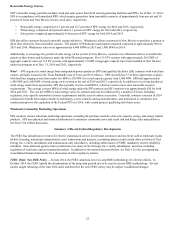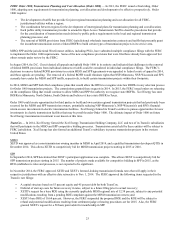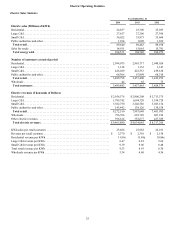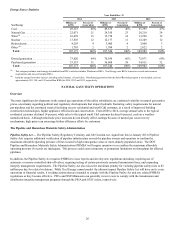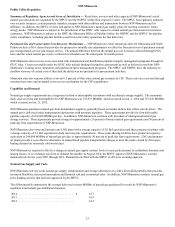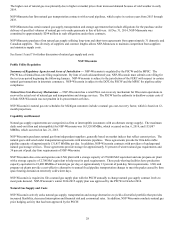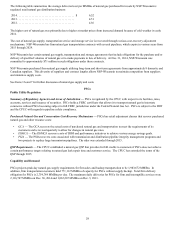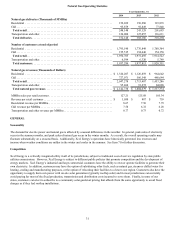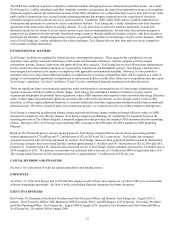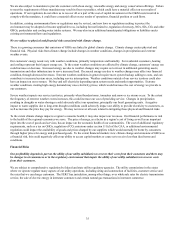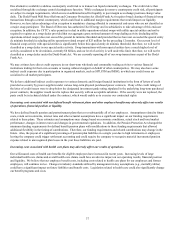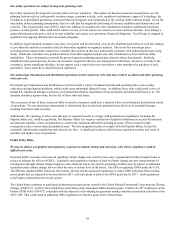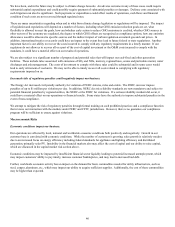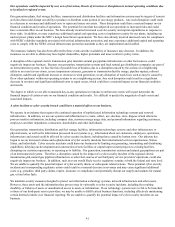Xcel Energy 2014 Annual Report Download - page 50
Download and view the complete annual report
Please find page 50 of the 2014 Xcel Energy annual report below. You can navigate through the pages in the report by either clicking on the pages listed below, or by using the keyword search tool below to find specific information within the annual report.32
The FERC has continued to promote competitive wholesale markets through open access transmission and other means. As a result,
Xcel Energy Inc.’s utility subsidiaries and their wholesale customers can purchase the output from generation resources of competing
wholesale suppliers and use the transmission systems of the utility subsidiaries on a comparable basis to serve their native load. State
public utilities commissions have created resource planning programs that promote competition in the acquisition of electricity
generation resources used to provide service to retail customers. In addition, FERC Order 1000 seeks to establish competition for
construction and operation of certain new electric transmission facilities. Xcel Energy Inc.’s utility subsidiaries also have franchise
agreements with certain cities subject to periodic renewal. If a city elected not to renew the franchise agreement, it could seek
alternative means for its citizens to access electric power or gas, such as municipalization. Several states have policies designed to
promote the development of solar and other distributed energy resources through significant incentive policies; with these incentives
and federal tax subsidies, distributed generating resources are potential competitors to Xcel Energy’s electric service business. While
each of Xcel Energy Inc.’s utility subsidiaries faces these challenges, Xcel Energy believes their rates and services are competitive
with currently available alternatives.
ENVIRONMENTAL MATTERS
Xcel Energy’s facilities are regulated by federal and state environmental agencies. These agencies have jurisdiction over air
emissions, water quality, wastewater discharges, solid wastes and hazardous substances. Various company activities require
registrations, permits, licenses, inspections and approvals from these agencies. Xcel Energy has received all necessary authorizations
for the construction and continued operation of its generation, transmission and distribution systems. Xcel Energy’s facilities have
been designed and constructed to operate in compliance with applicable environmental standards. However, it is not possible to
determine when or to what extent additional facilities or modifications of existing or planned facilities will be required as a result of
changes to environmental regulations, interpretations or enforcement policies or what effect future laws or regulations may have upon
Xcel Energy’s operations. See Item 7 and Notes 12 and 13 to the consolidated financial statements for further discussion.
There are significant future environmental regulations under consideration to encourage the use of clean energy technologies and
regulate emissions of GHGs to address climate change. Xcel Energy has undertaken a number of initiatives to meet current
requirements and prepare for potential future regulations, reduce GHG emissions and respond to state renewable and energy efficiency
goals. If these future environmental regulations do not provide credit for the investments we have already made to reduce GHG
emissions, or if they require additional initiatives or emission reductions, then their requirements would potentially impose additional
substantial costs. We believe, based on prior state commission practice, we would recover the cost of these initiatives through rates.
Xcel Energy is committed to addressing climate change and potential climate change regulation through efforts to reduce its GHG
emissions in a balanced, cost-effective manner. Xcel Energy adopted a methodology for calculating CO2 emissions based on the
reporting protocols of The Climate Registry, a nonprofit organization that provides and compiles GHG emissions data from reporting
entities. Starting in 2011, Xcel Energy began reporting GHG emissions to the EPA under the EPA’s mandatory GHG Reporting
Program.
Based on The Climate Registry’s current reporting protocol, Xcel Energy estimated that its current electric generating portfolio
emitted approximately 57.6 million and 57.2 million tons of CO2 in 2014 and 2013, respectively. Xcel Energy also estimated
emissions associated with electricity purchased for resale to Xcel Energy customers from generation facilities owned by third parties.
Xcel Energy estimates these non-owned facilities emitted approximately 11.4 million and 14.7 million tons of CO2 in 2014 and 2013,
respectively. Estimated total CO2 emissions associated with service to Xcel Energy electric customers decreased by 3.0 million tons in
2014 compared to 2013. The decrease in emissions was associated with a decrease of 5.4 million net MWh of generation since 2011.
The average annual decrease in CO2 emissions since 2011 is approximately 3.1 million tons of CO2 per year.
CAPITAL SPENDING AND FINANCING
See Item 7 for a discussion of expected capital expenditures and funding sources.
EMPLOYEES
As of Dec. 31, 2014, Xcel Energy had 11,589 full-time employees and 102 part-time employees, of which 5,588 were covered under
collective-bargaining agreements. See Note 9 to the consolidated financial statements for further discussion.
EXECUTIVE OFFICERS
Ben Fowke, 56, Chairman of the Board, President and Chief Executive Officer and Director, Xcel Energy Inc., August 2011 to
present. Chief Executive Officer, NSP-Minnesota, NSP-Wisconsin, PSCo, and SPS January 2015 to present. Previously, President
and Chief Operating Officer, Xcel Energy Inc., August 2009 to August 2011; Executive Vice President and Chief Financial Officer,
Xcel Energy Inc., December 2008 to August 2009.


